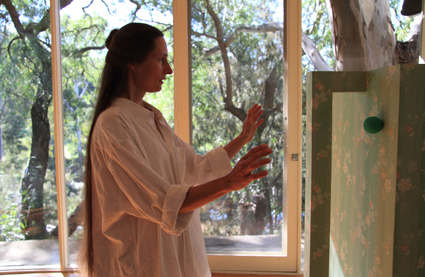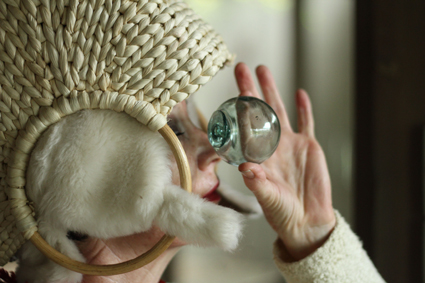from the living room into the world
keith gallasch: david young, chamber made opera

Deborah Kayser, The Box
photo Daisy Noyes
Deborah Kayser, The Box
APPOINTED IN 2009 TO THE ARTISTIC DIRECTORSHIP OF MELBOURNE’S CHAMBER MADE OPERA, DAVID YOUNG (FORMERLY ARTISTIC DIRECTOR OF APHIDS) HAD, HE SAYS, “A BRIEF TO RE-ENERGISE CMO AND TO TAKE IT IN A COMPLETELY NEW DIRECTION. SO WE’VE FOCUSED ON WHAT I THINK I CAN DO BEST WHICH IS TO MAKE NEW WORK THAT CROSSES THE BOUNDARIES OF CONTEMPORARY MUSIC, PERFORMANCE, THEATRE AND VISUAL ARTS, BRINGING ALL THESE TOGETHER, WHICH IS WHAT OPERA HAS ALWAYS DONE.”
Young also knew he had to do it “on a scale that was manageable for the company while retaining the level of quality—the pristine nature of the productions—that CMO had always been associated with. But I knew I wasn’t ever going to be able to do that on a huge mainstage and at a huge cost, not on the budget I had. Hence it wasn’t rocket science for me to look to where chamber music had started—in the home, in the living room. This gave us advantages: not just manageable scale, but it also allowed us to take risks we couldn’t with a big commission. And I’ve been able to give the artists completely free rein. It was incredible that Daniel Schlusser made a work [Ophelia Doesn’t Live Here Anymore, 2011] that he wouldn’t have made in a theatre—living room opera pushed him into a completely new space.”
CMO now has a considerable number of works in repertoire, “seven to eight within two years,” waiting to manifest in other living rooms or translate to theatres or galleries. “It depends on the particular work,” says Young, “Some are very site specific. The Box [2012, see RT109] was realised in a beautiful Robin Boyd-designed house, known as The Iris, on the Yarra Bend, a spectacular setting. It’s a very unassuming building actually, but you really feel like you’re in a tree house. The location is a big part of the experience, responding to the natural environment, the sounds, the house itself. But would The Box work without this house? Over 20 years I’ve translocated shows from one place or one city to another. Some work translates directly; you change nothing. Others have to be re-configured totally—that’s pretty much the case with the living room operas unless you can find a similar house or build one in a theatre. Malthouse is turning the Beckett Theatre into a living room for our co-production with Rawcus, Another Lament (RT101), featuring Ida Duelund Hansen, a wonderful Danish double bass player and singer. It premiered in 2011 in a home in suburban Armidale. We’re having a number of a very active conversations about placing our works.”
CMO is also involved in community engagement: “I have a very broad view of living rooms, as I have of opera,” Young quips. “The ‘Venny’ is an amazing adventure playground in Kensington located very close to a lot of public housing populated with people from very diverse backgrounds, culturally and economically. I thought it would be good for an extreme performance company to work with this community and give them access to contemporary performance. It’s very much a pilot. It will culminate in April with an opera performance involving the children and our musicians. We hope it will be of long term benefit for the community, for the playground and an opportunity for further work with us.”

Hellen Sky, Minotaur, Chamber Made Opera
photo Daisy Noyes
Hellen Sky, Minotaur, Chamber Made Opera
Young always sees his work in an international perspective: “It’s really essential that Australian art engages with the rest of the world. It’s so easy, particularly in Melbourne, to think that the whole world is here because we’re so far away and because we have at least one of everything, of each kind of venue and company. It’s so important to work with artists from other places—as a reality check, to get a sense of what else is happening and understand where we fit in.” Chamber Made is engaging in an exchange program with LOD Music Theatre in Ghent. “It’s a contemporary chamber opera and music theatre company. It’s one of the companies most aesthetically aligned with us and also in scale. So we’ve committed to a two-year partnership which will begin with an exchange residency. First, artists will come from LOD and then Australians will go to Ghent in June. Our hope is that this will lead to a co-production which will premiere in Belgium in December 2013 and then play in Australia and, possibly, tour in Europe.”
It’s already a busy year for CMO with Fritz Hauser (Switzerland) having performed his solo gong work, Schraffur, at the Melbourne Recital Centre in March; the premiere of The Box (with Aphids, Fritz Hauser, Boa Baumann, Speak Percussion and Deborah Kayser) also in March; Minotaur (2011) travelling to the Aurora music festival in Western Sydney in May (see p14); and Another Lament at Malthouse in June as part of the XS Opera Festival.
What about the rest of the year? “Even busier,” the indefatigable Young declares. “There are the Nova Workshops with Opera Victoria: four works in two showings in December, one by Mary Finsterer which she has been working on for 10 years. The relationship with Victorian Opera has been wonderfully collegial and mutually supportive. We’re also running our second librettist workshop. There’s a real gap; very few places professionally develop librettists. It’s a kind of boot camp and one of the most successful things that came out of last year’s workshop was a ‘speed dating’ session between librettists and composers, 20 of each. We’re doing that again.” It’s clear that Young sees CMO as playing a nurturing role, whether in the development of new opportunities for composers through the living room and in-repertoire model, in community engagement and in skill development and partnering. Later in 2012, the Minotaur Trilogy will premiere and CMO will develop a new multimedia work.
It’s with a sense of jubilation and relief that Young declares, “The Box has been a breakthrough. It sold out a week before opening and I feel we now really know what we’re doing.” David Young’s idiosyncratic approach to art-making—multidisciplinary collaborations, site specificity, inventive sponsorship and commissioning models, the nurturing of new work and an international perspective—has reinvigorated and reinvented Chamber Made Opera and is breathing much-needed new life into Australian music theatre.
Chamber Made Opera, www.chambermadeopera.com
RealTime issue #108 April-May 2012 pg. 36






